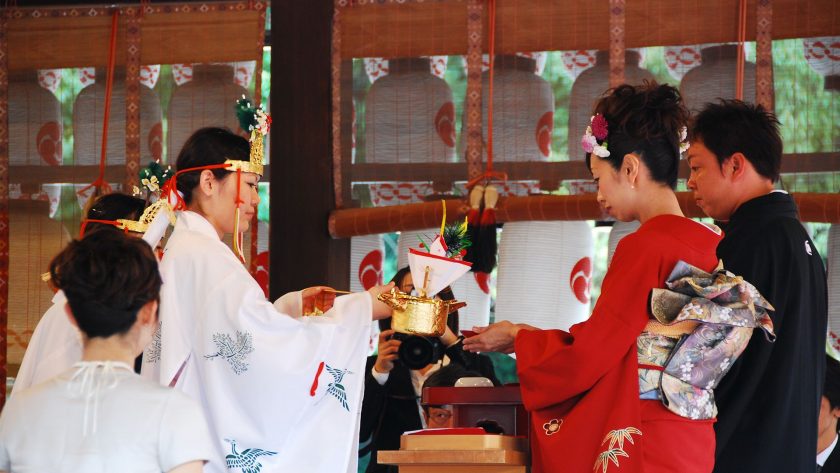
Traditional Japanese weddings incorporate a wide range of aspects, ranging from the most traditional to modern interpretations. Japanese wedding rituals and traditions have evolved to incorporate elements of both Japanese and Western culture. Here are 11 Japanese wedding traditions you may not be aware of:
Yuino, often spelled Yui-no

The Yuino, or engagement/betrothal ritual, entails the meeting of the two families and the exchange of presents. This was quite common when arranged marriages were still common in Japan, and it is less usual today, but it still happens following a proposal. The gifts are typically a variety of goods, each expressing a positive hope for the marriage, such as Shiraga (hemp thread), which indicates the longing for the couple to grow old together, or a fan, which represents affluence. as well as development

Weddings are typically held in the Shinto tradition.
Traditionally, a Japanese couple would marry in a shrine in Shinto style. A Shinto priest officiates the ceremony. Shinto, Japan’s original faith, is the country’s principal religion, alongside Buddhism. At this time, holding a wedding in Shinto style is the most frequent in Japan.
The duo dresses in a variety of clothes.

A few outfit alterations are to be expected, especially for brides. In general, both members of the marriage will wear traditional Kimono at a traditional wedding. Grooms typically wear montsuki, a black traditional kimono. In general, the couple does not have a bridal party.

Even non-Christian couples can incorporate features of Christian weddings into their ceremonies.
There are several in Japan. There are four major wedding styles: Shinto, Christian, Buddhist, and non-religious. Many brides have been influenced by western society and now want to wear white gowns and have their marriages in a Christian church, even if they are not Christians. Other popular wedding customs include the cutting of the cake, the exchange of rings, the bouquet throw, and honeymoons. Japanese brides will sometimes wear something old, something new, something borrowed, and something blue.

Purification
The pair is purified before the nuptial cups, which means they have been exorcised of evil spirits.
San san ku do – Nuptial cups

Instead of vows, the bride and groom sip sake three times from three distinct sakazuki cups. Following that, their parents take drinks, symbolising the solidifying of the link between the two families. Everyone takes a turn. three drinks from each cup—each swig having a different meaning.

The first three sips represent the three couples, the second three sips indicate hatred, passion, and ignorance (please bear with me here), and the last three sips represent freedom from those three imperfections. The phrase san san ku do means “three, three, and nine,” while the “do” component implies “deliverance from faults.” In Japanese culture, the number nine is considered lucky.
Shiro-muku
The bride will wear a traditional white kimono called “shiro-muku” in ceremonies when the couple chooses a Shinto style. This represents purity and the notion that the bride will take on the colour of her new husband’s family. If the bride wears a brightly coloured wedding kimono It’s known as iro-uchikake. A bride wears her hair in a bun and carries a little pocketbook known as a hakoseko, a miniature sword known as a kaiken, and a fan in her obi belt, which is thought to signify her joyful future.
Shugi-bukuro

When attending a Japanese wedding reception, it is customary to present a cash gift in an envelope known as shugi-bukuro. Before signing the guestbook, write your name on the front of the envelope and hand it to the receptionist. Guests often give 30,000 yen (about $350) in gifts.
Take the centre stage.

The couple sits on a stage during the wedding celebration. During this period, guests frequently offer speeches and perform. Songs for the pair, for example. Following the cutting of the wedding cake, the couple generally greets their guests and lights candles.
Dinner for the reception
A colourful sushi display, as well as seabream, prawns, and red rice, is common at Japanese weddings. There is also a ceremonial sake opening during the reception, in which the lid of a sake barrel is cracked open and sake is served to all of the attendees. This is known as kagami-biraki.

Favours
In Japan, favours or bomboniere are referred to as hikidemono, which is also referred to as a wedding souvenir. Sweets, sake cups, and tablewares are popular wedding favours. A contemporary trend has evolved in which guests can select gifts from a catalogue. Japanese couples typically spend between $40 and $90 on bomboniere for their guests!



